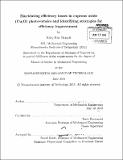Elucidating efficiency losses in cuprous oxide (Cu₂O) photovoltaics and identifying strategies for efficiency improvement
Author(s)
Brandt, Riley Eric
DownloadFull printable version (13.05Mb)
Other Contributors
Massachusetts Institute of Technology. Department of Mechanical Engineering.
Advisor
Tonio Buonassisi.
Terms of use
Metadata
Show full item recordAbstract
In this thesis, I fabricated and characterized a series of thin-film cuprous oxide (Cu₂O) photovoltaic devices. I constructed several different device designs, using sputtered and electrochemically deposited Cu₂O. Characterization was done using XRD, SEM, optical spectroscopy, quantum efficiency, current-voltage, and capacitance-voltage measurements. Then, these devices were modeled using SCAPS-1D, a numerical simulation package, as well as MATLAB for analytical solutions. This simulation enabled a quantitative breakdown of efficiency losses in Cu 20 devices. Simulations suggest that low device efficiencies of 0.3-0.6% may be explained in part by poor bulk transport properties in the Cu₂O. However, the predominant efficiency loss comes from an unoptimized p-n heterojunction, in which a large negative conduction band offset and structural defects lead to a low built-in voltage and high recombination activity. The effects of interface engineering are demonstrated in experiment and simulation. Broader simulations suggest opportunities for future efficiency improvements towards 10%. These include the improvement of bulk properties, the selection of alternative pairing materials, novel device structures, and the possibility of multijunction cells.
Description
Thesis (S.M.)--Massachusetts Institute of Technology, Dept. of Mechanical Engineering, 2013. Cataloged from PDF version of thesis. Includes bibliographical references (p. 95-99).
Date issued
2013Department
Massachusetts Institute of Technology. Department of Mechanical EngineeringPublisher
Massachusetts Institute of Technology
Keywords
Mechanical Engineering.